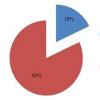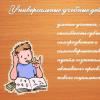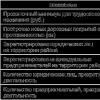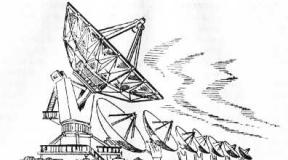From which tablets Anaprilin 10 mg. Anaprilin: instructions for use. Application for impaired renal function
tablets
Owner / Registrar
BIOSINTEZ, JSC
International Classification of Diseases (ICD-10)
D35.0 Adrenal gland E05 Thyrotoxicosis [hyperthyroidism] F10.3 Withdrawal state G43 Migraine I10 Essential [primary] hypertension I20 Angina pectoris [angina pectoris] I20.0 Unstable angina I47.1 Supraventricular tachycardia and non-recurrent atrial fibrillation I48 Atrial fibrillation. depolarizationPharmacological group
Beta1-, beta2-blocker
pharmachologic effect
Non-selective beta-blocker... It has antihypertensive, antianginal and antiarrhythmic effects. Due to the blockade of β-adrenergic receptors, it reduces the formation of cAMP from ATP stimulated by catecholamines, as a result of which it reduces the intracellular intake of calcium ions, has a negative chrono-, dromo-, batmo- and inotropic effect (reduces heart rate, inhibits conductivity and excitability, reduces myocardial contractility). At the beginning of the use of beta-blockers, OPSS increases in the first 24 hours (as a result of a reciprocal increase in the activity of α-adrenergic receptors and elimination of stimulation of β 2 -adrenergic receptors of the vessels of skeletal muscles), but after 1-3 days it returns to the initial one, and decreases with prolonged use.
The hypotensive effect is associated with a decrease in the minute blood volume, sympathetic stimulation of peripheral vessels, a decrease in the activity of the renin-angiotensin system (it is important in patients with initial hypersecretion of renin), the sensitivity of the aortic arch baroreceptors (there is no increase in their activity in response to a decrease in blood pressure) and the effect on Central nervous system. The antihypertensive effect stabilizes by the end of 2 weeks of the course appointment.
The antianginal effect is due to a decrease in myocardial oxygen demand (due to a negative chronotropic and inotropic effect). A decrease in heart rate leads to a lengthening of diastole and an improvement in myocardial perfusion. By increasing the end-diastolic pressure in the left ventricle and increasing the stretching of the muscle fibers of the ventricles, oxygen demand can increase, especially in patients with chronic heart failure.
The antiarrhythmic effect is due to the elimination of arrhythmogenic factors (tachycardia, increased sympathetic activity nervous system, increased content of cAMP, arterial hypertension), a decrease in the rate of spontaneous excitation of sinus and ectopic pacemakers and a slowdown in AV conduction. Suppression of impulse conduction is observed mainly in the antegrade and to a lesser extent in the retrograde directions through the AV node and along additional pathways. It belongs to the II class of antiarrhythmic drugs. Reducing the severity of myocardial ischemia - due to a decrease in myocardial oxygen demand, postinfarction mortality can also decrease due to antiarrhythmic action.
The ability to prevent the development of vascular headaches is due to a decrease in the severity of the expansion of cerebral arteries due to beta-blockade of vascular receptors, inhibition of platelet aggregation and lipolysis caused by catecholamines, a decrease in platelet adhesion, prevention of activation of blood coagulation factors during the release of adrenaline in tissue, stimulation of the flow of blood renin.
A decrease in tremor against the background of the use of propranolol is mainly due to the blockade of peripheral β 2 -adrenergic receptors.
Increases atherogenic properties of blood. Strengthens the contractions of the uterus (spontaneous and caused by drugs that stimulate the myometrium). Increases the tone of the bronchi. In high doses, it causes sedation.
Potential mechanisms of action of propranolol in infantile hemangioma include the following interrelated healing effects: local hemodynamic effect (vasoconstriction due to beta-adrenergic blockade and decreased blood flow to the hemangioma focus); antiangiogenic effect (decrease in proliferation, neovascularization and tubulogenesis of endothelial cells due to a decrease in the activity of a key factor in the migration of endothelial cells - matrix metalloproteinase MMP-9); the effect of induction of apoptosis in endothelial cells due to the blockade of β-adrenergic receptors. It is known that stimulation of β 2 -adrenergic receptors can lead to the release of vascular endothelial growth factors VEGF and bFGF and induce endothelial cell proliferation. Propranolol, by blocking β 2 -adrenergic receptors, suppresses the expression of VEGF and bFGF and inhibits angiogenesis. The therapeutic efficacy of propranolol was defined as complete or almost complete involution (resorption) of the hemangioma. Obtained during clinical research data show that the effectiveness of propranolol did not differ significantly in subgroups divided by age (35-90 days / 91-150 days), gender and location of hemangioma (head / body); positive dynamics after 5 weeks of treatment with propranolol was noted in 88% of patients.
Pharmacokinetics
After oral administration, about 90% of the dose taken is absorbed, but bioavailability is low due to metabolism during the "first pass" through the liver. C max in blood plasma is reached after 1-1.5 hours. Protein binding is 93%. T 1/2 is 3-5 hours. It is excreted by the kidneys mainly in the form of metabolites, unchanged - less than 1%.
Arterial hypertension; exertional angina, unstable angina; sinus tachycardia(including with hyperthyroidism), supraventricular tachycardia, tachysystolic form of atrial fibrillation, supraventricular and ventricular premature beats, essential tremor, prevention of migraine, alcohol withdrawal (agitation and tremor), anxiety and pheochromic-auxiliary treatment with zoster thyrotoxic crisis (as an adjuvant, including with intolerance to thyrostatic drugs), sympathoadrenal crises against the background of diencephalic syndrome.
Proliferating infantile hemangioma requiring systemic therapy: hemangioma that is life-threatening or negative influence on the functioning of body systems; ulcerative hemangioma, characterized by pain and / or lack of response to previous measures for the treatment of ulceration; hemangioma with a potential risk of permanent scars or deformities.
AV block II and III degree, sinoatrial block, bradycardia (heart rate less than 55 beats / min), SSSU, arterial hypotension (systolic blood pressure less than 90 mm Hg, especially in myocardial infarction), chronic heart failure stage IIB-III , acute heart failure, cardiogenic shock, hypersensitivity to propranolol.
For newborns and infants: liver failure; kidney failure; bronchial asthma, history of bronchospasm; AV block II-III degree; SSSU, including sinoatrial blockade; a decrease in heart rate below the following limits: at the age from 0 to 3 months - 100 beats / min, from 3 months to 6 months - 90 beats / min, from 6 months to 12 months - 80 beats / min; decrease in blood pressure below the following limits: at the age from 0 to 3 months - 65/45 mm Hg, from 3 months to 6 months - 70/50 mm Hg, from 6 months to 12 months - 80/55 mm hg .; uncontrolled heart failure; Prinzmetal's angina; severe violations of the peripheral arterial circulation (Raynaud's disease); predisposition to hypoglycemia; pheochromocytoma (without the simultaneous use of alpha-blockers); children who are breastfed, if the mother is taking medications that are not recommended to be used simultaneously with propranolol; children under the age of 5 weeks on the day of starting treatment; children over the age of 5 months on the day of initiation of treatment.
From the nervous system: increased fatigue, weakness, dizziness, headache, drowsiness or insomnia, vivid dreams, depression, anxiety, confusion, hallucinations, tremors, nervousness, restlessness.
From the senses: decreased secretion of tear fluid (dry and sore eyes).
sinus bradycardia, AV blockade (up to the development of complete transverse blockade and cardiac arrest), arrhythmias, development (worsening) of chronic heart failure, lowering blood pressure, orthostatic hypotension, manifestation of angiospasm (increased disturbance of peripheral circulation, cold snap lower limbs, Raynaud's syndrome), chest pain.
nausea, vomiting, epigastric discomfort, constipation or diarrhea, liver dysfunction (dark urine, yellowness of the sclera or skin, cholestasis), taste changes, increased activity of hepatic transaminases, LDH.
nasal congestion, bronchospasm.
From the side endocrine system: change in blood glucose concentration (hypo- or hyperglycemia).
From the hematopoietic system: thrombocytopenia (unusual bleeding and hemorrhage), leukopenia.
Dermatological reactions: increased sweating, psoriasis-like skin reactions, exacerbation of psoriasis symptoms.
Allergic reactions: itching, skin rash, urticaria.
Others: back pain, arthralgia, decreased potency, withdrawal syndrome (increased angina attacks, myocardial infarction, increased blood pressure).
In newborns and infants
From the nervous system: insomnia, poor sleep quality, hypersomnia, nightmares, agitation, irritability, drowsiness.
From the side of cardio-vascular system: AV block, bradycardia, lowering blood pressure, angiospasm, Raynaud's disease.
From the respiratory system: bronchitis, bronchiolitis, bronchospasm.
From the side digestive system: decreased appetite, diarrhea, vomiting, constipation, abdominal pain.
On the part of the skin and subcutaneous tissues: erythema, urticaria, alopecia.
Others: cold extremities, decreased plasma glucose concentration, hyperkalemia, agranulocytosis, hypoglycemic convulsions.
special instructions
Use with caution in patients with bronchial asthma, COPD, with bronchitis, decompensated heart failure, diabetes mellitus, with renal and / or hepatic failure, hyperthyroidism, depression, myasthenia gravis, psoriasis, occlusive peripheral vascular disease, during pregnancy, during lactation, in elderly patients, in children (efficacy and safety have not been determined).
With caution in newborns and infants: cardiovascular disease, heart failure; diabetes; respiratory diseases; psoriasis; PHACE syndrome; hyperkalemia; allergic reactions history.
During the treatment period, an exacerbation of psoriasis is possible.
With pheochromocytoma, propranolol can be used only after taking an alpha-blocker.
After a long course of treatment, propranolol should be withdrawn gradually, under the supervision of a physician.
During treatment with propranolol, intravenous administration of verapamil, diltiazem should be avoided. A few days before anesthesia, it is necessary to stop taking propranolol or choose an anesthesia drug with a minimal negative inotropic effect.
Influence on the ability to drive vehicles and use mechanisms
In patients whose activities require increased attention, the issue of using propranolol on an outpatient basis should be decided only after assessing the patient's individual response.
With renal failure
Use with caution in patients with renal insufficiency.
In case of liver dysfunction
Use with caution in patients with hepatic impairment.
Elderly
Use with caution in elderly patients.
Application during pregnancy and lactation
The use of propranolol during pregnancy is possible only if the intended benefit to the mother outweighs the potential risk to the fetus. If it is necessary to use it during this period, careful monitoring of the condition of the fetus is necessary, 48-72 hours before delivery, propranolol should be canceled.
It should be borne in mind that a negative effect on the fetus is possible: intrauterine growth retardation, hypoglycemia, bradycardia.
Propranolol is excreted in breast milk. If necessary, use during lactation should establish medical supervision of the child or stop breastfeeding.
Drug interactions
With simultaneous use with hypoglycemic agents, there is a risk of developing hypoglycemia due to the enhancement of the action of hypoglycemic agents.
With simultaneous use with MAO inhibitors, there is a possibility of developing undesirable manifestations of drug interactions.
Cases of the development of severe bradycardia with the use of propranolol for arrhythmia caused by digitalis drugs have been described.
With simultaneous use with agents for inhalation anesthesia, the risk of inhibition of myocardial function and the development of arterial hypotension increases.
With simultaneous use with amiodarone, arterial hypotension, bradycardia, ventricular fibrillation, asystole are possible.
With simultaneous use with verapamil, arterial hypotension, bradycardia, dyspnea are possible. The C max in the blood plasma increases, the AUC increases, the clearance of propranolol decreases due to the inhibition of its metabolism in the liver under the influence of verapamil.
Propranolol does not affect the pharmacokinetics of verapamil.
A case of severe arterial hypotension and cardiac arrest with simultaneous use with haloperidol is described.
With simultaneous use with hydralazine, C max in blood plasma and AUC of propranolol increase. It is believed that hydralazine can reduce hepatic blood flow or inhibit the activity of hepatic enzymes, which leads to a slowdown in the metabolism of propranolol.
With the simultaneous use of propranolol can inhibit the effects of glibenclamide, glyburide, chlorpropamide, tolbutamide, because non-selective beta 2 -adrenergic blockers are able to block the β 2 -adrenergic receptors of the pancreas associated with insulin secretion.
The insulin release from the pancreas caused by the action of sulfonylurea derivatives is inhibited by beta-blockers, which to some extent prevents the development of the hypoglycemic effect.
With simultaneous use with diltiazem, the concentration of propranolol in the blood plasma increases due to the inhibition of its metabolism under the influence of diltiazem. An additive inhibitory effect on the activity of the heart is observed due to a slowdown in the conduction of the impulse through the AV node caused by diltiazem. There is a risk of developing severe bradycardia, the stroke and minute volume is significantly reduced.
With simultaneous use, cases of an increase in the concentration of warfarin and phenindione in blood plasma have been described.
With simultaneous use with doxorubicin in experimental studies, an increase in cardiotoxicity has been shown.
With the simultaneous use of propranolol prevents the development of the bronchodilating effect of isoprenaline, salbutamol, terbutaline.
With simultaneous use, cases of an increase in the concentration of imipramine in blood plasma have been described.
With simultaneous use with indomethacin, naproxen, piroxicam, acetylsalicylic acid, it is possible to reduce the antihypertensive effect of propranolol.
With simultaneous use with ketanserin, the development of an additive hypotensive effect is possible.
When used simultaneously with clonidine, the antihypertensive effect is enhanced.
In patients receiving propranolol, in the case of abrupt withdrawal of clonidine, severe arterial hypertension may develop. It is believed that this is due to an increase in the content of catecholamines in the circulating blood and an increase in their vasoconstrictor action.
With simultaneous use with caffeine, it is possible to reduce the effectiveness of propranolol.
With simultaneous use, it is possible to enhance the effects of lidocaine and bupivacaine (including toxic ones), apparently due to a slowdown in the metabolism of local anesthetics in the liver.
With simultaneous use with lithium carbonate, a case of the development of bradycardia is described.
With simultaneous use, a case of increased side effects of maprotiline has been described, which is apparently due to a slowdown in its metabolism in the liver and accumulation in the body.
With simultaneous use with mefloquine, the QT interval increases, a case of cardiac arrest has been described; with morphine - the inhibitory effect on the central nervous system caused by morphine is enhanced; with sodium amidotrizoate - cases of severe arterial hypotension have been described.
With simultaneous use with nizoldipine, an increase in C max and AUC of propranolol and nizoldipine in blood plasma is possible, which leads to severe arterial hypotension. There is a message about increased beta-blocking action.
Cases of an increase in C max and AUC of propranolol, arterial hypotension and a decrease in heart rate have been described with simultaneous use with nicardipine.
With simultaneous use with nifedipine in patients with coronary artery disease, severe arterial hypotension may develop, an increase in the risk of developing heart failure and myocardial infarction, which may be due to an increase in the negative inotropic effect of nifedipine.
Patients receiving propranolol are at risk of developing severe arterial hypotension after taking the first dose of prazosin.
When used simultaneously with prenylamine, the QT interval increases.
With simultaneous use with propafenone, the concentration of propranolol in the blood plasma increases and develops toxic effect... It is believed that propafenone inhibits the metabolism of propranolol in the liver, decreasing its clearance and increasing serum concentrations.
With the simultaneous use of reserpine, other antihypertensive drugs, the risk of developing arterial hypotension and bradycardia increases.
With simultaneous use, the C max and AUC of risatriptan increase; with rifampicin - the concentration of propranolol in the blood plasma decreases; with suxamethonium chloride, tubocurarine chloride - it is possible to change the action of muscle relaxants.
With simultaneous use, the clearance of theophylline decreases due to a slowdown in its metabolism in the liver. There is a risk of developing bronchospasm in patients with bronchial asthma or COPD. Beta-blockers can block the inotropic effect of theophylline.
With simultaneous use with phenindione, cases of a slight increase in bleeding without changes in blood coagulation indicators have been described.
With simultaneous use with flecainide, an additive cardiodepressant effect is possible.
Fluoxetine inhibits the CYP2D6 isoenzyme, which leads to inhibition of propranolol metabolism and its cumulation, and may enhance the cardiodepressant effect (including bradycardia). Fluoxetine and, mainly, its metabolites are characterized by a long T 1/2, so the likelihood of drug interactions persists even several days after discontinuation of fluoxetine.
Quinidine inhibits the isoenzyme CYP2D6, which leads to inhibition of the metabolism of propranolol, while its clearance decreases. Possible increased beta-adrenergic blocking action, orthostatic hypotension.
With simultaneous use in blood plasma, the concentrations of propranolol, chlorpromazine, thioridazine increase. A sharp decrease in blood pressure is possible.
Cimetidine inhibits the activity of microsomal liver enzymes (including the isoenzyme CYP2D6), this leads to inhibition of the metabolism of propranolol and its cumulation: there is an increase in the negative inotropic effect and the development of cardiodepressant action.
With simultaneous use, the hypertensive effect of epinephrine increases, there is a risk of developing severe life-threatening hypertensive reactions and bradycardia. The bronchodilating effect of sympathomimetics (epinephrine, ephedrine) decreases.
With simultaneous use, cases of a decrease in the effectiveness of ergotamine have been described.
There are reports of a change in the hemodynamic effects of propranolol when used simultaneously with ethanol.
For adults, when taken orally, the initial dose is 20 mg, single dose- 40-80 mg, the frequency of administration is 2-3 times / day.
Intravenous jet slowly - initial dose of 1 mg; then, after 2 minutes, the same dose is administered again. If there is no effect, repeated administrations are possible.
Maximum doses: when taken orally - 320 mg / day; at repeated introductions i / v stream total dose - 10 mg (under the control of blood pressure and ECG).
In children aged 35 days to 150 days on the day of initiation of treatment, it is intended for oral administration in a special dosage form. For premature babies, the appropriate age should be determined by subtracting the number of weeks of premature pregnancy from the actual age of the baby. The initial dose is 1 mg / kg / day in 2 divided doses (in the morning and in the evening, 0.5 mg / kg). The recommended therapeutic dose is 3 mg / kg / day in 2 divided doses (in the morning and in the evening, 1.5 mg / kg). The interval between two doses should be at least 9 hours. Dose titration scheme: 1 mg / kg / day for 1 week; 2 mg / kg / day for the 2nd week; from the 3rd week - 3 mg / kg / day. When dose titration is complete, the amount of drug administered is adjusted depending on the child's body weight. Clinical monitoring of the child's condition and dose adjustment should be carried out at least 1 time per month. On the first day of treatment and on days of increasing the dose, the child should be in medical institution under the supervision of the attending physician for 2 hours after the administration of the drug. It is necessary to measure the heart rate and evaluate general state a child at least every 60 minutes during the first 2 hours after drug administration. The duration of treatment is 6 months. Discontinuation of the drug does not require a gradual dose reduction. In the event of a relapse of the disease after completion of therapy, treatment can be repeated if there is a satisfactory response.
Horse racing blood pressure- a problem that many modern people face, not only in old age, but also at a young age. There are many drugs that modern pharmacology offers to eliminate such an ailment. One of these medicines is Coronal - the instructions for use should be considered in detail. Let's also dwell on its pros and cons.
- Composition of the preparation
- Indications for use
- Side effects
- Overdose
- Contraindications for use
- Compatibility with other drugs
- Amlodipine and Coronal
- Coronal and Panangin
- Analogs
- Concor or Coronal - which is better
- Coronal or Egilok - which is better
| Instructions for use of the drug Diroton |
Composition of the preparation
This drug of the group of adrenergic blockers is presented in the form of 5 mg tablets, which are film-coated. The active ingredient is bisoprolol fumarate. Also, each tablet contains the following auxiliary components:
- corn starch;
- microcrystalline cellulose;
- titanium dioxide;
- sodium lauryl sulfate;
- colloidal silicon dioxide;
- magnesium stearate.

As for the film shell, it consists of the following components:
- hypromellose;
- titanium dioxide;
- yellow or red dye.
In Russia, the drug can be purchased in pharmacies at an average cost of 120 rubles. In Ukraine, the price is approximately 50 UAH.
Indications for use
What is Coronal prescribed for? Instructions for use provide for the use of this drug for such ailments:
- high blood pressure;
- Heart arythmy;
- prevention of angina pectoris in people diagnosed with coronary heart disease.
Also in some cases this drug appointed during the rehabilitation period after myocardial infarction.

The drug is used in morning time after awakening, 2.5 mg. In this way, blood pressure decreases and the condition improves as a result of angina attacks and tension in coronary heart disease. If the required effect from such a dosage is not observed, then it can be increased. The maximum amount of Coronal per day is 10 mg.
Can I take it in the evening? To achieve the desired effect and normal condition during the day, it is better to do this in the morning.
How long can Coronal be taken without interruption? The duration of treatment with this medication is at least 3 months, but you should consult your doctor before using it.

Practically all medications are contraindicated for women during pregnancy. As for Coronal, it is prescribed to pregnant women only in cases where the therapeutic effect for the expectant mother is much higher than the risk for the fetus. Usually this drug is prescribed for this group of women for cardiac arrhythmias. This condition interferes with the normal course of pregnancy.
After giving birth during the period breastfeeding it is required to refuse the use of Coronal, since the components of the drug enter the newborn's body along with breast milk.
Side effects
The use of this drug can cause a number of side effects:
- The cardiovascular system. The patient may complain of a sharp drop in blood pressure, low pulse, coldness of the upper and lower extremities, and their swelling.
- Central nervous system. Dizziness, constant drowsiness, headaches, depression, apathy, sleep disturbances may occur.
- The gastrointestinal tract. Coronal causes nausea, sometimes with vomiting, constant thirst, constipation, or diarrhea.
- Sense organs. The patient may experience deterioration in vision, hearing, soreness and dryness of the eyes.
- Respiratory system. In case of an overdose of the drug, breathing difficulties, shortness of breath, bronchospasm are observed.
- Skin. The patient has increased sweating, allergic rashes, urticaria.
In addition, the patient may be disturbed general weakness organism and rapid fatigue.
Overdose

With excessive use of the drug, the patient may experience a low pulse, low blood pressure, heart failure acute form, severe dizziness up to loss of consciousness, shortness of breath, difficulty breathing, convulsions.
To eliminate such side effects, the patient urgently needs to rinse the stomach, and then call an ambulance medical assistance... The specialist should prescribe symptomatic treatment.
Contraindications for use
This drug should not be taken by people with the following ailments:
- heart failure during an exacerbation;
- all types of shock;
- stage of decompensation at chronic form heart failure;
- sick sinus syndrome;
- pronounced low pulse;
- low blood pressure;
- bronchial asthma;
- poor circulation in an advanced stage;
- hypersensitivity to drugs of the group of adrenergic blockers.
Also, this medication is not recommended for use in childhood up to 18 years old.
Compatibility with other drugs
For some patients, the attending physician prescribes complex treatment, which involves the use of several drugs. Their combined use does not always give a positive trend towards recovery. The compatibility of the most popular drugs with Coronal should be considered in more detail.

The active ingredient in Nebilet is nebivolol. This drug lowers blood pressure and also normalizes heart function. Joint application Nebileta and Coronal is inappropriate for bronchial asthma, diseases of the respiratory system, which are chronic in nature, as well as diabetes. In such situations, this can significantly worsen the patient's condition.
Amlodipine and Coronal
Amlodipine belongs to the group of calcium antagonists. It effectively lowers blood pressure, but has many side effects. Therefore, the joint intake of these drugs should be carried out strictly observing the dosage prescribed by the doctor.
Coronal and Panangin
The compatibility of these medications can only be determined by the attending physician. Usually Coronal and Panangin are prescribed in combination with high blood pressure. The doctor recommends the most effective dosage to relieve the patient's condition.
Analogs
V modern pharmacology there are many drugs with similar effects. Most Popular Russian counterparts should be considered in more detail.

Concor or Coronal - which is better
Concor and Coronal are one and the same. Therefore, the data medications are in equal demand in the CIS countries. Coronal's advantage is its low price in comparison with Concor, although the effect on the body of these drugs is identical.
Coronal or Egilok - which is better
The active ingredient of Egilok is metoprolol, therefore, they cannot be called direct analogues. However, they belong to the group of adrenergic blockers. Therefore, the effect on the body and side effects they have almost the same. As for the period of action, Egilok affects the patient's body much faster, but it should be taken 2-3 times a day. Coronal has more long-term action, therefore, to normalize the condition, 1 tablet per day is enough.
What else can replace Coronal? In addition to the above drugs, analogues are: Bisoprolol, Betalok, Bisoprolol, Anaprilin, Niperten. The choice of any drug must be accompanied by a doctor's prescription.
Metoprolol
- pharmachologic effect
- Pharmacokinetics
- Indications for use
- Dosage
- Side effects
- Contraindications
- Pregnancy and breastfeeding
- Drug interactions
- Overdose
- Release form
- Storage conditions and periods
- Compound
- The use of metoprolol
- Dosage forms: tartrate and succinate
- Clinical researches
- Comparison with other beta blockers
- Prices in online pharmacies
- Dosage of metoprolol for various diseases
- How to switch to bisoprolol or carvedilol
- Patient Testimonials
- Frequently asked questions and answers to them
- conclusions
Metoprolol is a medicine that doctors often prescribe for hypertension, coronary heart disease, chronic heart failure, as well as for the prevention of the first and repeated heart attacks. It has been in use since the 1980s and has been well studied. Metoprolol exists in two dosage forms: tartrate and succinate. There are differences between the two that are important to understand. These are detailed below in the article. According to the classification, metoprolol belongs to beta-blockers. It reduces the action of adrenaline and other stimulating hormones on the heart muscle. Due to this, the pulse becomes less frequent, blood pressure normalizes, and the load on the heart decreases. Below you will find instructions for use, written in accessible language. Read the indications for use, contraindications, dosages. Find out how to take metoprolol - before or after meals, for how long, in what dosage.
Metoprolol: instructions for use
| pharmachologic effect | Selective beta1-blocker. Reduces the stimulating effect that adrenaline and other hormones, catecholamines, have on the heart. Thus, the drug prevents an increase in pulse rate, minute volume and increased contractility of the heart. With emotional stress and physical exertion, a sharp release of catecholamines occurs, but blood pressure does not rise so much. |
| Pharmacokinetics | Metoprolol is rapidly and completely absorbed. Reception simultaneously with food can increase its bioavailability by 30-40%. Extended-release tablets contain microgranules, of which active substance- metoprolol succinate - slowly released. Therapeutic effect lasts more than 24 hours. The fast-acting metoprolol tartrate tablets cease their effect no later than after 10-12 hours. This drug undergoes oxidative metabolism in the liver, but approximately 95% of the administered dose is excreted by the kidneys. |
| Indications for use |
Important! Heart failure, reduced mortality and re-infarction rates are indications only for metoprolol succinate, extended-release tablets. Fast-acting tablets of metoprolol tartrate for heart failure and after a heart attack should not be prescribed. |
Watch also a video on the treatment of coronary artery disease and angina pectoris
| Dosage | Read more about the dosage of metoprolol succinate and tartrate preparations for hypertension, angina pectoris, heart failure - read here. The tablets can be halved, but must not be chewed or crumbled. May be taken with food or on an empty stomach, whichever is more convenient. The dose must be selected individually for each patient and increased slowly so that bradycardia does not develop - the pulse is below 45-55 beats per minute. |
| Side effects | Frequent side effects:
For any rare or severe side effects - see your doctor immediately! |
| Contraindications |
|
| Pregnancy and breastfeeding | The use of fast-acting or "slow" metoprolol tablets during pregnancy is possible only if the benefits to the mother outweigh the risks to the fetus. Like other beta-blockers, metoprolol can theoretically cause side effects - bradycardia in the fetus or newborn. V breast milk a small amount of the drug is released. With the appointment of medium therapeutic doses, the risk of side effects for the infant is not high. However, you need to carefully monitor the child's possible signs of blockade of beta-adrenergic receptors. |
| Drug interactions | Non-steroidal anti-inflammatory drugs reduce the blood pressure lowering effect of metoprolol. Other drugs for hypertension, on the contrary, increase it. Do not take this drug at the same time as verapamil or diltiazem. Given list drug interactions metoprolol is not complete. Tell your doctor about all medications, supplements, and herbs you are taking before your prescription for hypertension and heart disease is prescribed. |
| Overdose | Symptoms are low heart rate and other heart problems. Also, suppression of lung function, impaired consciousness, possibly uncontrolled tremors, convulsions, increased sweating, nausea, vomiting, fluctuations in blood sugar. Treatment - first of all, taking activated charcoal and gastric lavage. Further - resuscitation measures in the intensive care unit. |
| Release form | Tablets of 25 mg, 50 mg, 100 mg, 200 mg, film-coated. |
| Storage conditions and periods | Store at a temperature not exceeding 30 ° C, shelf life - 3 years. Do not use after the expiration date printed on the package. |
| Compound | The active substance is metoprolol succinate or tartrate. Excipients: methylcellulose; glycerol; corn starch; ethyl cellulose; magnesium stearate. Film shell: hypromellose, stearic acid, titanium dioxide (E171). |
How to take metoprolol
First of all, make sure that you are prescribed a drug whose active ingredient is metoprolol succinate. Today, there is no reason to use outdated tablets containing metoprolol tartrate. They need to be taken several times a day, which is inconvenient for patients. They cause spikes in blood pressure. It is harmful to blood vessels. Take Betaloc ZOK or Egilok S at the dosage indicated by the doctor and for as long as the doctor recommends. These medications need to be taken for a long time - several years, or even for life. They are not suitable for situations where you need to quickly bring down blood pressure or relieve an attack of chest pain.
How long can I take metoprolol?
Metoprolol should be taken for as long as directed by your doctor. Visit your healthcare professional regularly for follow-up examinations and consultations. You can not arbitrarily take breaks, cancel the drug or reduce its dosage. Live a healthy lifestyle while taking a beta blocker and other prescribed medications. This is the main treatment for hypertension and cardiovascular disease. If you do not follow the recommendations for healthy way life, then over time, even the most expensive pills will stop helping.
How to take metoprolol: before or after meals?
The official instructions do not indicate how metoprolol should be taken - before or after meals. Authoritative site on English language(http://www.drugs.com/food-interactions/metoprolol,metoprolol-succinate-er.html) says that preparations containing metoprolol succinate and tartrate should be taken with meals. Food enhances the effect of the drug as compared to taking it on an empty stomach. Find out what a low-carb diet is and how it is beneficial for hypertension and cardiovascular disease. Talk with your doctor if you can follow it.
Are metoprolol and alcohol compatible?
Tablets containing metoprolol tartrate are poorly tolerated, and alcohol consumption further increases their side effects. Hypotension may occur - blood pressure will drop too low. Hypotension symptoms: dizziness, weakness, even loss of consciousness. Preparations with metoprolol succinate as the active ingredient are compatible with reasonable alcohol consumption. You can drink alcohol only if you are able to maintain moderation. Getting drunk while taking beta-blockers is dangerous. It is advisable not to drink alcohol for the first 1-2 weeks after starting treatment with metoprolol, as well as after increasing the dose of the drug. During these transition periods, it should also not be managed vehicles and dangerous mechanisms. 
Prices for drugs in which the active ingredient is metoprolol succinate
Prices for drugs in which the active ingredient is metoprolol tartrate
The use of metoprolol
Metoprolol is a popular worldwide medicine for arterial hypertension, coronary heart disease, cardiac arrhythmias. Since the 2000s, additional indications to use. He was also prescribed for chronic heart failure, along with traditional drugs - ACE inhibitors, diuretics and others. Let's see how metoprolol works, what its dosage forms exist and how they differ from each other.
- The best way to recover from hypertension (quickly, easily, good for health, without "chemical" drugs and dietary supplements)
- Hypertonic disease - folk way recover from it at stages 1 and 2
- The causes of hypertension and how to eliminate them. Analyzes for hypertension
- Effective hypertension treatment without medication
Adrenaline and other hormones, which are referred to as catecholamines, stimulate the heart muscle. As a result, the pulse rate and blood volume, which the heart pumps with each beat, increases. Blood pressure rises. Beta-blockers, including metoprolol, weaken (block) the effect of catecholamines on the heart. As a result, blood pressure and heart rate drop. The load on the heart is reduced. The risk of the first and repeated heart attack decreases. The life expectancy of people who develop coronary heart disease or chronic heart failure is increasing.
Dosage forms of metoprolol: tartrate and succinate
In tablets, metoprolol is contained in the form of salts - tartrate or succinate. Traditionally, metoprolol tartrate has been used to produce fast-acting tablets, from which the drug enters the bloodstream immediately. Succinate - for sustained release dosage forms. Extended-release metoprolol succinate tablets are manufactured using CR / XL (Controlled Release / Extended Release) or ZOK (Zero-Order-Kinetics) technologies. Rapid-acting metoprolol tartrate has significant disadvantages. It is inferior in effectiveness to newer beta-blockers and is less well tolerated.
| How many times a day to take | 2-4 times a day | It is enough to take once a day. Each dose taken lasts for about 24 hours. |
| Stable concentration of the active substance in the blood | Not | Yes |
| Inhibits the development of atherosclerosis | Not | Yes, slightly enhances the effect of statin drugs |
| Tolerability, frequency of side effects | Poorly tolerated than sustained-release metoprolol tablets | Good tolerance, side effects are rare |
| Effectiveness in heart failure | Weak | Yes, comparable to other modern beta blockers |
Most of the studies that have proven the effectiveness of metoprolol in cardiovascular disease have used sustained-release preparations containing succinate. The manufacturers of metoprolol tartrate could not indifferently watch this and retaliated. In the mid-2000s, a “delayed” tartrate called Egilok retard began to be sold in Russian-speaking countries.
In medical journals, there was a wave of articles proving that it helps no worse than metoprolol succinate, in particular, the original drug Betaloc ZOK. However, these articles are not credible. Because they were clearly funded by the pill manufacturer Egilok retard. In such a situation, it is impossible to conduct objective comparative studies of drugs. In the English-language sources, it was not possible to find any information about the sustained-release metoprolol tartrate preparations.
Clinical researches
Metoprolol tablets have been prescribed to patients for hypertension and cardiovascular disease since the 1980s. Dozens of large-scale studies of this beta-blocker have been carried out, with the participation of thousands of patients. Their results are published in reputable medical journals.
| Hjalmarson A., Goldstein S., Fagerberg B. et al. Effects of controlled-release metoprolol on total mortality, hospitalizations, and well-being in patients with heart failure: the metoprolol CR / XL randomized intervention trial in congestive heart failure (MERIT-HF). JAMA 2000; 283: 1295-1302. | Effect of taking metoprolol in sustained-release tablets on overall mortality, hospitalization rate, and quality of life in patients with chronic heart failure | Sustained release metoprolol succinate is effective in heart failure. However, this study did not compare it to other beta blockers. |
| Deedwania PC, Giles TD, Klibaner M, Ghali JK, Herlitz J, Hildebrandt P, Kjekshus J, Spinar J, Vitovec J, Stanbrook H, Wikstrand J. Efficacy, safety and tolerability of metoprolol CR / XL in patients with diabetes and chronic heart failure: experiences from MERIT-HF. American Heart Journal 2005, 149 (1): 159-167. | Efficacy, safety and tolerability of metoprolol succinate in patients with diabetes and chronic heart failure. Data from the MERIT-HF study. | Patients with type 2 diabetes tolerate metoprolol succinate, prescribed for the treatment of chronic heart failure, well. The drug improves survival and reduces hospital admissions. However, it does not increase blood sugar. |
| Wiklund O., Hulthe J., Wikstrand J. et al. Effect of controlled release / extended release metoprolol on carotid intima-media thickness in patients with hypercholesterolemia: a 3-year randomized study. Stroke 2002; 33: 572-577. | The effect of metoprolol in sustained-release tablets on the thickness of the intima-media complex of the carotid artery in patients with high cholesterol in blood. Data from a 3-year study, compared with placebo. | Metoprolol in sustained-release tablets (succinate) inhibits the development of atherosclerosis if given to patients in addition to statins. |
| Heffernan KS, Suryadevara R, Patvardhan EA, Mooney P, Karas RH, Kuvin JT. Effect of atenolol vs metoprolol succinate on vascular function in patients with hypertension. Clin Cardiol. 2011, 34 (1): 39-44. | Comparison of the effect of atenolol and metoprolol succinate on vascular function in patients with high blood pressure. | Atenolol and metoprolol succinate equally lower blood pressure. At the same time, metoprolol protects blood vessels better. |
| Cocco G. Erectile dysfunction after therapy with metoprolol: the hawthorne effect. Cardiology 2009, 112 (3): 174-177. | Erectile dysfunction while taking metoprolol. | Weakening of potency in men while taking metoprolol succinate is caused in at least 75% of cases psychological attitude rather than the real action of the drug. Placebo restores potency no worse than tadalafil (Cialis). |
We emphasize that only metoprolol succinate has a solid evidence base. It works well, especially when combined with other medications, and rarely causes side effects. In particular, this beta blocker does not impair male potency. Metoprolol tartrate cannot boast of any special advantages. Today it is no longer advisable to use it, even though the price is low.
Comparison with other beta blockers
Recall that metoprolol has been used in medical practice since the 1980s. Even the metoprolol succinate sustained release tablets with improved performance are no longer new. This beta blocker has a large share of the pharmaceutical market. Doctors know him well and readily prescribe him to their patients. However, other drugs are trying to squeeze it out.
Beta blockers - competitors of metoprolol:
| Espinola-Klein C, Weisser G, Jagodzinski A, Savvidis S, Warnholtz A, Ostad MA, Gori T, Munzel T. Beta-Blockers in patients with intermittent claudication and arterial hypertension: results from the nebivolol or metoprolol in arterial occlusive disease trial. Hypertension 2011, 58 (2): 148-54 | The action of beta-blockers in patients with intermittent claudication and high blood pressure. Results of a comparative study of nebivolol and metoprolol in patients with circulatory disorders in the peripheral arteries. | Metoprolol and nebivolol work equally well for patients with circulatory disorders in the legs. There is no difference in effectiveness between drugs. |
| Kampus P, Serg M, Kals J, Zagura M, Muda P, Karu K, Zilmer M, Eha J. Differential effects of nebivolol and metoprolol on central aortic pressure and left ventricular wall thickness. Hypertension. 2011, 57 (6): 1122-8. | Differences in the effect of nebivolol and metoprolol on central aortic pressure and left ventricular wall thickness. | Nebivolol and metoprolol lower heart rate and mean blood pressure equally. However, only nebivolol significantly normalizes central SBP, DBP, central pulse pressure and left ventricular wall thickness. |
| Phillips RA, Fonseca V, Katholi RE, McGill JB, Messerli FH, Bell DS, Raskin P, Wright JT Jr, Iyengar M, Anderson KM, Lukas MA, Bakris GL. Demographic analyzes of the effects of carvedilol vs metoprolol on glycemic control and insulin sensitivity in patients with type 2 diabetes and hypertension in the Glycemic Effects in Diabetes Mellitus: Carvedilol-Metoprolol Comparison in Hypertensives (GEMINI) study. Journal of the CardioMetabolic Syndrome 10/2008; 3 (4): 211-217. | Demographic analysis of the effect of carvedilol and metoprolol on glycemic control and insulin sensitivity in patients with type 2 diabetes and hypertension. Research data from GEMINI. | In type 2 diabetics, carvedilol has a better metabolic effect than metoprolol. However, the study used metoprolol tartrate rather than succinate. |
| Acikel S, Bozbas H, Gultekin B, Aydinalp A, Saritas B, Bal U, Yildirir A, Muderrisoglu H, Sezgin A, Ozin B. Comparison of the efficacy of metoprolol and carvedilol for preventing atrial fibrillation after coronary bypass surgery. International Journal of Cardiology 2008, 126 (1): 108-113. | Comparison of the effectiveness of metoprolol and carvedilol in preventing arterial fibrillation after surgery coronary artery bypass grafting. | In patients undergoing coronary bypass surgery, carvedilol is better at preventing atrial fibrillation than metoprolol succinate. |
| Remme WJ, Cleland JG, Erhardt L, Spark P, Torp-Pedersen C, Metra M, Komajda M, Moullet C, Lukas MA, Poole-Wilson P, Di Lenarda A, Swedberg K. Effect of carvedilol and metoprolol on the mode of death in patients with heart failure. European Journal of Heart Failure 2007, 9 (11): 1128-1135. | The effect of carvedilol and metoprolol on the causes of mortality in patients with heart failure. | In patients with heart failure, carvedilol is better at reducing all-cause mortality than metoprolol tartrate, and especially stroke mortality. |
It is possible that competing beta-blockers are superior to metoprolol. However, metoprolol succinate extended-release tablets are also helpful. And doctors are conservative. They are in no hurry to replace the drugs that they have long been accustomed to prescribing to patients with others. Moreover, metoprolol preparations have a relatively affordable price... In pharmacies, the demand for Betalok ZOK, Egilok S, Metoprolol-Ratiopharm tablets, if it falls, is slow, or remains stably high.
Dosage of metoprolol for various diseases
Metoprolol is found in tablets in the form of one of two salts - tartrate or succinate. They act in different ways, provide a different rate of entry of the active substance into the blood. Therefore, for the fast-acting tablets of metoprolol tartrate one dosage regimen, and for the "slow" metoprolol succinate - another. Note that metoprolol tartrate is not indicated in heart failure.
| Arterial hypertension | 50-100 mg once a day. If necessary, the dose can be increased to 200 mg per day, but it is better to add another antihypertensive agent - a diuretic, a calcium antagonist, an ACE inhibitor. | 25-50 mg twice a day, morning and evening. If necessary, the dose can be increased to 100-200 mg per day or other drugs that lower blood pressure can be added |
| Angina pectoris | 100-200 mg once a day. If necessary, another antianginal drug can be added to therapy. | The initial dose is 25-50 mg, taken 2-3 times a day. Depending on the effect, this dose can be gradually increased to 200 mg per day or another medicine for angina pectoris can be added. |
| Stable chronic heart failure, functional class II | The recommended starting dose is 25 mg once a day. After two weeks of treatment, the dose may be increased to 50 mg once daily. Further - to double every two weeks. The maintenance dose for long-term treatment is 200 mg once a day. | Not shown |
- Causes, symptoms, diagnosis, medications and folk remedies from CH
- Diuretic medicines for edema in heart failure: details
- Frequently asked questions about HF - fluid and salt restriction, shortness of breath, diet, alcohol, disability
- Heart failure in the elderly: treatment features
Watch also the video:
| Stable chronic heart failure III-IV functional class | It is recommended to start with a dose of 12.5 mg (1/2 tablet 25 mg) once daily for the first two weeks. The dose is selected individually. After 1-2 weeks from the start of treatment, the dose may be increased to 25 mg once a day. Then, after another 2 weeks, the dose can be increased to 50 mg once a day. Etc. Patients who tolerate the beta blocker well can double the dose every 2 weeks until maximum dose- 200 mg once a day. | Not shown |
| Heart rhythm disturbances | 100-200 mg once a day. | The initial dose is 25-50 mg 2-3 times a day. If necessary daily dose you can gradually increase to 200 mg / day or add another agent that normalizes the heart rate. |
| Supportive care after myocardial infarction | The target dose is 100-200 mg per day, in one or two doses. | The usual daily dose is 100-200 mg, divided into two doses, morning and evening. |
| Functional cardiac dysfunctions accompanied by tachycardia | 100 mg once a day. If necessary, the dose can be increased to 200 mg per day. | The usual daily dose is 50 mg 2 times a day, in the morning and in the evening. If necessary, it can be increased up to 2 times 100 mg. |
| Prevention of migraine attacks (headache) | 100-200 mg once a day | The usual daily dose is 100 mg, divided into two doses, morning and evening. If necessary, it can be increased to 200 mg / day, also divided into 2 doses. |
A note on the dosage of metoprolol succinate in heart failure. If the patient develops bradycardia, ie, the pulse falls below 45-55 beats per minute, or the "upper" blood pressure is below 100 mm Hg. Art., it may be necessary to temporarily reduce the dose of the medication. At the beginning of treatment, there may be arterial hypotension. However, after a while, in many patients, the body adapts, and they normally tolerate therapeutic doses of the drug. Drinking alcohol increases the side effects of metoprolol, so it is better to abstain from alcohol.
How to switch to bisoprolol or carvedilol
It may happen that the patient needs to switch from metoprolol to bisoprolol (Concor, Biprol or another) or carvedilol. The reasons may vary. In theory, replacing one beta blocker with another does not offer significant benefits. In practice, gains may appear. Because the effectiveness and tolerance of drugs for each person is individual. Or the usual metoprolol tablets may simply disappear from the market, and they will have to be replaced with another drug. You may find the table below helpful.
Source - DiLenarda A, Remme WJ, Charlesworth A. Exchange of beta-blockers in heart failure patients. Experiences for the poststudy phase of COMET (the Carvedilol or Metoprolol European Trial). European Journal of Heart Failure 2005; 7: 640-9.
The table shows metoprolol succinate. For metoprolol tartrate in rapid-release tablets, the equivalent total daily dose is approximately 2 times higher. Bisoprolol is taken once a day, carvedilol - 1-2 times a day.
Arterial hypertension; exertional angina; unstable angina; sinus tachycardia (including with hyperthyroidism); supraventricular tachycardia; atrial fibrillation; supraventricular and ventricular premature beats; prevention of myocardial infarction (systolic blood pressure over 100 mm Hg); pheochromocytoma (together with alpha-blockers); essential tremor; migraine (prevention of attacks); as an adjuvant in the treatment of thyrotoxicosis and thyrotoxic crisis (with intolerance to thyrostatic medicines); sympatho-adrenal crises against the background of diencephalic syndrome.
Pharmacotherapeutic group
Beta blocker.
Pharmacological property
Non-selective beta-blocker. It has antianginal, hypotensive and antiarrhythmic effects. Non-selectively blocking beta-adrenergic receptors (75% beta1- and 25% beta2-adrenergic receptors), reduces the formation of cAMP from ATP stimulated by catecholamines, as a result of which it reduces intracellular calcium intake, has a negative chrono-, dromo-, batmo- and inotropic effect (reduces the frequency heart rate, inhibits conduction and excitability, reduces myocardial contractility). At the beginning of the use of beta-blockers, the total peripheral vascular resistance increases in the first 24 hours (as a result of a reciprocal increase in the activity of alpha-adrenergic receptors and elimination of stimulation of beta2-adrenergic receptors of the skeletal muscle vessels), but after 1-3 days it returns to the initial value, and with prolonged administration it decreases ... The hypotensive effect is associated with a decrease in the minute volume of the heart, sympathetic stimulation of peripheral vessels, a decrease in the activity of the reninangiotensin system (it is important in patients with initial hypersecretion of renin), the sensitivity of the aortic arch baroreceptors (there is no increase in their activity in response to a decrease in blood pressure) and the effect on the central nervous system. The antihypertensive effect stabilizes by the end of 2 weeks of the course appointment. The antianginal effect is due to a decrease in myocardial oxygen demand (due to a negative chronotropic and inotropic effect). A decrease in heart rate leads to a lengthening of diastole and an improvement in myocardial perfusion. By increasing the end-diastolic pressure in the left ventricle and increasing the stretching of the muscle fibers of the ventricles, oxygen demand can increase, especially in patients with chronic heart failure. The antiarrhythmic effect is due to the elimination of arrhythmogenic factors (tachycardia, increased activity of the sympathetic nervous system, increased cAMP content, arterial hypertension), a decrease in the rate of spontaneous excitation of sinus and ectopic pacemakers, and a slowdown in atrioventricular conduction. Suppression of impulse conduction is observed mainly in the antegrade and to a lesser extent in the retrograde directions through the atrioventricular node and along additional pathways. According to the classification of antiarrhythmic drugs, it belongs to group II drugs. Reducing the severity of myocardial ischemia? by reducing myocardial oxygen demand, postinfarction mortality can also be reduced due to antiarrhythmic action. The ability to prevent the development of vascular headaches is due to a decrease in the severity of the expansion of cerebral arteries due to beta-blockade of vascular receptors, inhibition of platelet aggregation and lipolysis caused by catecholamines, a decrease in platelet adhesion, prevention of activation of blood coagulation factors during the release of adrenaline in tissue, stimulation of the flow of blood renin. A decrease in tremor against the background of the use of propranolol may be due to the blockade of beta2-adrenergic receptors. Increases atherogenic properties of blood. Strengthens uterine contractions (spontaneous and caused by drugs that stimulate the myometrium). Increases the tone of the bronchi.
Contraindications
Hypersensitivity to the drug, atrioventricular block II-III degree, sinoauricular block, sinus bradycardia, arterial hypotension, uncontrolled chronic heart failure IIB-III degree, acute heart failure, acute myocardial infarction (systolic blood pressure? Less than 100 mm Hg) , cardiogenic shock, pulmonary edema, sick sinus syndrome, Prinzmetal's angina, cardiomegaly (no signs of heart failure), vasomotor rhinitis, peripheral vascular occlusive disease, diabetes mellitus, metabolic acidosis(including diabetic ketoacidosis), bronchial asthma, a tendency to bronchospastic reactions, chronic obstructive pulmonary disease (including a history), pheochromocytoma (without the simultaneous use of alpha-blockers), spastic colitis, concomitant use with antipsychotics and anxiolytics (chlorpromazine, trioxazine, etc.), monoamine oxidase inhibitors, lactation period, age up to 18 years (efficacy and safety have not been established). Carefully. Hepatic and / or renal failure, hyperthyroidism, myasthenia gravis, heart failure, pheochromocytoma, psoriasis, pregnancy, history of allergic reactions, Raynaud's syndrome, old age.
Application
With arterial hypertension inside, 40 mg 2 times a day. If the hypotensive effect is insufficient, the dose is increased to 40 mg 3 times or 80 mg 2 times a day. Maximum daily dose? 320 mg For angina pectoris, cardiac arrhythmias? at an initial dose of 20 mg 3 times a day, then the dose is increased to 80-120 mg in 2-3 doses. Maximum daily dose? 240 mg For the prevention of migraine, as well as essential tremor? at an initial dose of 40 mg 2-3 times a day, if necessary, the dose is gradually increased to 160 mg / day. In case of impaired liver function, a decrease in the dose of the drug is necessary. In case of impaired renal function, it is necessary to reduce the initial dose or increase the interval between doses of the drug. myocardium? start therapy between the 5th and 21st days after myocardial infarction at a dose of 40 mg 4 times a day for 2-3 days. Then at a dose of 80 mg 2 times a day. In case of pheochromocytoma? use only with blockers of alpha-adrenergic receptors. Before the operation, appoint 60 mg per day, for 3 days.
Side effects
From the side of the cardiovascular system: sinus bradycardia, atrioventricular block, heart failure, palpitations, myocardial conduction disturbances, arrhythmias, lowering blood pressure, orthostatic hypotension, chest pain, peripheral arterial spasm, cold extremities, mesenteric thrombosis. From the digestive system: dryness of the oral mucosa, nausea, vomiting, diarrhea, constipation, pain in the epigastric region, impaired liver function, change in taste, ischemic colitis. From the nervous system: headache, insomnia, "nightmares", asthenic syndrome, agitation, depression, paresthesia, increased fatigue, weakness, dizziness, drowsiness, confusion or short-term memory loss, hallucinations, tremors, catatonia, emotional lability, decrease the speed of psychomotor reactions. From the respiratory system: rhinitis, nasal congestion, shortness of breath, bronchospasm, laryngospasm. From the side of metabolism: hypoglycemia (in patients with diabetes mellitus Type 1), hyperglycemia (in patients with type 2 diabetes). From the senses: dryness of the mucous membrane of the eyes (decreased secretion of lacrimal fluid), impaired visual acuity, keratoconjunctivitis. On the part of the reproductive system: decreased libido, decreased potency, Peyronie's disease. On the part of the skin: alopecia, exacerbation of the course of psoriasis, increased sweating, skin flushing, exanthema, psoriasis-like skin reactions, Stevens-Johnson syndrome, toxic epidermal necrolysis, exfoliative dermatitis, erythema multiforme. From the endocrine system: decreased thyroid function. Allergic reactions: skin rash, itching. Laboratory indicators: agranulocytosis, increased activity of "hepatic" transaminases and the concentration of bilirubin. Others: muscle weakness, back or joint pain, pain in chest, leukopenia, thrombocytopenia, withdrawal syndrome.
Overdose
Symptoms: Bradycardia, dizziness or fainting, low blood pressure, arrhythmias, difficulty breathing, cyanosis of the fingernails or palms, or seizures. Treatment: gastric lavage, the appointment of activated carbon, in violation of atrioventricular conduction? 1-2 mg of atropine, epinephrine is injected intravenously, with low efficiency, a temporary pacemaker is installed; with ventricular premature beats? lidocaine (class IA drugs are not used); with arterial hypotension, the patient should be in the Trendelenburg position. If there are no signs of pulmonary edema, plasma-substituting solutions are injected intravenously, if ineffective? epinephrine, dopamine, dobutamine; with convulsions? intravenous diazepam; with bronchospasm inhalation or parenteral? beta adrenostimulants.
Interaction with other medicinal products
The antihypertensive effect of propranolol is enhanced when combined with diuretics, reserpine, hydralazine and other antihypertensive drugs, as well as ethanol. The antihypertensive effect is weakened by non-steroidal anti-inflammatory drugs (sodium retention and blocking of prostaglandin synthesis by the kidneys), estrogens (sodium retention) and monoamine oxidase inhibitors. Cimetidine increases bioavailability. Increases the concentration of lidocaine in the blood plasma, reduces the clearance of theophylline. Concomitant administration with phenothiazine derivatives increases plasma concentrations of both drugs. Strengthens the effect of thyreostatic and uterotonizing drugs; reduces the effect of antihistamines. Increases the likelihood of developing severe systemic reactions (anaphylaxis) against the background of the introduction of allergens used for immunotherapy or for skin tests. Amiodarone, verapamil and diltiazem? increasing the severity of the negative chrono-, ino- and dromotropic action of propranolol. Iodine-containing X-ray contrast drugs for intravenous administration increase the risk of anaphylactic reactions. Phenytoin for intravenous administration, drugs for inhalation general anesthesia (hydrocarbon derivatives) increase the severity of the cardiodepressant effect and the likelihood of lowering blood pressure. Changes the effectiveness of insulin and oral hypoglycemic drugs, masks the symptoms of developing hypoglycemia (tachycardia, increased blood pressure). Reduces the clearance of xanthines (except diphyllin). The antihypertensive effect is weakened by glucocorticosteroids. Cardiac glycosides, methyldopa, reserpine and guanfacine, antiarrhythmic drugs increase the risk of developing or worsening bradycardia, atrioventricular block, cardiac arrest, and heart failure. Nifedipine can lead to a significant decrease in blood pressure. Prolongs the action of non-depolarizing muscle relaxants and the anticoagulant effect of coumarins. Tri- and tetracyclic antidepressants, antipsychotic drugs (antipsychotics), ethanol, sedatives and hypnotics increase the depression of the central nervous system. Simultaneous use with monoamine oxidase inhibitors is not recommended due to a significant increase in the hypotensive effect, the break in treatment between taking monoamine oxidase inhibitors and propranolol should be at least 14 days. Unhydrogenated ergot alkaloids increase the risk of developing peripheral circulatory disorders. Sulfasalazine increases the concentration of propranolol in the blood plasma (inhibits metabolism), rifampicin shortens the half-life.
Anaprilin is an antihypertensive, antianginal and antiarrhythmic drug. The instructions for use explain at what pressure to take tablets 10 mg and 40 mg. Reviews of patients and doctors report that this drug helps to treat angina pectoris, hypertension, and cardiac arrhythmias.
Release form and composition
Anaprilin dosage form - tablets. The active substance is propranolol, in 1 tablet its content reaches 10 or 40 mg. Auxiliary components: milk sugar, potato starch, calcium stearate, talc.
pharmachologic effect
Anaprilin instructions for use refer to non-selective beta-blockers. It has antihypertensive, antianginal and antiarrhythmic effects. Due to the blockade of beta-adrenergic receptors, it reduces the formation of cAMP from ATP stimulated by catecholamines, as a result of which it reduces the intracellular intake of calcium ions, has a negative chrono-, dromo-, batmo- and inotropic effect (reduces heart rate, inhibits conductivity and excitability, reduces myocardial contractility).
At the beginning of the use of beta-blockers, OPSS increases in the first 24 hours (as a result of a reciprocal increase in the activity of alpha-adrenergic receptors and elimination of stimulation of beta2-adrenergic receptors of the vessels of skeletal muscle), but after 1-3 days it returns to the initial one, and decreases with prolonged use.
Pressure reducing properties
The hypotensive effect is associated with a decrease in the minute blood volume, sympathetic stimulation of peripheral vessels, a decrease in the activity of the renin-angiotensin system (it is important in patients with initial hypersecretion of renin), the sensitivity of the aortic arch baroreceptors (there is no increase in their activity in response to a decrease in blood pressure) and the effect on Central nervous system.
The antihypertensive effect stabilizes by the end of the 2nd week of the course appointment. The antianginal effect is due to a decrease in myocardial oxygen demand (due to a negative chronotropic and inotropic effect). A decrease in heart rate leads to a lengthening of diastole and an improvement in myocardial perfusion.
By increasing the end-diastolic pressure in the left ventricle and increasing the stretching of the muscle fibers of the ventricles, oxygen demand can increase, especially in patients with chronic heart failure.
Antiarrhythmic action
The antiarrhythmic effect is due to the elimination of arrhythmogenic factors (tachycardia, increased activity of the sympathetic nervous system, increased cAMP content, arterial hypertension), a decrease in the rate of spontaneous excitation of sinus and ectopic pacemakers, and a slowdown in AV conduction.
Suppression of impulse conduction is observed mainly in the antegrade and to a lesser extent in the retrograde directions through the AV node and along additional pathways. Belongs to class 2 antiarrhythmic drugs. Reducing the severity of myocardial ischemia - due to a decrease in myocardial oxygen demand, postinfarction mortality can also decrease due to antiarrhythmic action.
The effectiveness of the drug
The ability to prevent the development of vascular headaches is due to a decrease in the severity of the expansion of cerebral arteries due to beta-blockade of vascular receptors, inhibition of platelet aggregation and lipolysis caused by catecholamines, a decrease in platelet adhesion, prevention of activation of blood coagulation factors during the release of adrenaline in tissue, stimulation of the flow of blood renin.
A decrease in tremor against the background of the use of propranolol (the active ingredient of the drug Anaprilin) is mainly due to the blockade of peripheral beta2-adrenergic receptors.
Increases atherogenic properties of blood. Strengthens the contractions of the uterus (spontaneous and caused by drugs that stimulate the myometrium). Increases the tone of the bronchi. In high doses, it causes sedation.
What does Anaprilin help from?
Indications for use of the medication include:
- arterial hypertension;
- prevention of migraine;
- unstable angina;
- thyrotoxic crisis and diffuse-toxic goiter - as an adjuvant, including with intolerance to thyrostatic drugs; exertional angina; hypertonic disease;
- pheochromocytoma (Anaprilin is used with alpha-blockers);
- various heart rhythm disturbances associated with lesions of the heart of a rheumatic nature (arrhythmia, atrial tachyarrhythmia, paroxysmal and sinus tachycardia, extrasystole);
- alcohol withdrawal (tremors and agitation).
At what pressure is prescribed
Anaprilin is indicated for admission when high blood pressure, the values of which are 140 and above.
Instructions for use
Anaprilin is taken 10-30 minutes before meals, washed down with a sufficient amount of liquid. Doses and frequency of administration are set depending on the underlying and concomitant diseases, the patient's age. The duration of the course of treatment is also determined by the doctor. On average, the duration of treatment for cardiovascular pathologies is 3-4 weeks.
If indicated, the course can be repeated. The interval between therapeutic courses should be 1–2 months. Below are the average recommended dosages of Anaprilin for adults according to the instructions for use of the drug.
In case of arrhythmias, it is prescribed 10-30 mg 3-4 times a day.
With arterial hypertension, the initial dose of the drug is 160 mg (80 mg twice a day). If necessary, the dose can be gradually increased to 320 mg per day.
With migraine, the daily dosage of Anaprilin is from 80 mg to 160 mg.
With angina pectoris, the first three days, the drug is taken at 20 mg four times a day, in the next three days the dose is increased to 40 mg three times a day and 20 mg in the fourth dose. From the seventh day, the drug is taken at 40 mg four times a day. If necessary, the dose is increased to 200-240 mg per day (40 mg 5-6 times a day).
After suffering myocardial infarction, Anaprilin is taken at 160 mg per day (40 mg 4 times a day).
Contraindications

Side effects
- arrhythmias;
- arthralgia;
- anxiety;
- anxiety;
- chest pain;
- backache;
- bronchospasm;
- hallucinations;
- headache;
- dizziness;
- depression;
- discomfort in the epigastric region;
- nasal congestion;
- constipation or diarrhea;
- change in blood glucose concentration (hypo- or hyperglycemia);
- changes in taste;
- skin rash;
- hives;
- nervousness;
- exacerbation of psoriasis symptoms;
- orthostatic hypotension;
- increased fatigue;
- manifestation of angiospasm (increased impairment of peripheral circulation, cooling of the lower extremities, Raynaud's syndrome);
- psoriasis-like skin reactions;
- development (worsening) of chronic heart failure;
- withdrawal syndrome (increased angina attacks, myocardial infarction, increased blood pressure);
- sinus bradycardia, AV block (up to the development of complete transverse blockade and cardiac arrest);
- weakness;
- decrease in blood pressure;
- decreased potency;
- drowsiness or insomnia;
- confusion of consciousness;
- nausea, vomiting;
- tremor;
- thrombocytopenia (unusual bleeding or hemorrhage), leukopenia;
- decreased secretion of tear fluid (dry and sore eyes);
- increased sweating.
Children, during pregnancy and breastfeeding
The drug is prescribed only when the intended benefit to the woman outweighs the potential risk to the fetus. During the use of Anaprilin, strict monitoring of the condition of the fetus is required. The drug must be canceled 3 days before delivery.
Possible negative effects on the fetus: bradycardia, hypoglycemia, intrauterine growth retardation. Also, the drug can cause fetal death or premature birth.
The active substance is absorbed into breast milk, therefore, breastfeeding women need to stop breastfeeding during treatment.
special instructions
Use with caution in patients with bronchial asthma, COPD, with bronchitis, decompensated heart failure, diabetes mellitus, with renal and / or hepatic failure, hyperthyroidism, depression, myasthenia gravis, psoriasis, occlusive peripheral vascular disease, during pregnancy, during lactation, in elderly patients, in children (efficacy and safety have not been determined).
Important! During the treatment period, an exacerbation of psoriasis is possible.
With pheochromocytoma, propranolol can be used only after taking an alpha-blocker.
Drug interactions
Due to the possible sharp drop in blood pressure, it is not recommended to take ethanol-containing drugs during treatment. Anaprilin should not be taken together with tranquilizers and neuroleptics (antipsychotic drugs).
The antihypertensive effect of the drug increases with the simultaneous administration of reserpine, hydrochlorothiazide, hydralazine and other antihypertensive drugs, weakened when taking estrogens, nonsteroidal anti-inflammatory drugs, MAO inhibitors (the interval between taking propranolol and monoamine oxidase inhibitors should not be less than 14 days).
Analogues of the drug Anaprilin
Structural analogs include drugs:
- Propranolol Nycomed.
- Propranolol hydrochloride.
- Obsessed.
- Inderal.
- Propranobene.
Vacation conditions and price
The average price of Anaprilin (40 mg tablets No. 50) in Moscow is 22 rubles. In Kiev, you can buy a medicine for 38 hryvnia, in Kazakhstan - for 110 tenge. Pharmacies in Minsk offer medicine for 0.5 bel. rubles. Dispensed from pharmacies with a prescription.
Post Views: 2 800
A drug Anaprilin- antiarrhythmic, hypotensive, antianginal drug.
Anaprilin reduces the automatism of the sinus node, myocardial excitability, the emergence of ectopic foci of excitation; has a membrane stabilizing effect, reduces heart rate, slows down AV conduction, reduces myocardial contractility and myocardial oxygen demand.
It has a hypotensive effect, which stabilizes by the end of the 2nd week of the course appointment. Reduces the activity of the renin-angiotensin system. Increases atherogenic properties of blood.
Strengthens uterine contractions (spontaneous and caused by drugs that stimulate the myometrium), which helps to reduce bleeding during childbirth and in the postoperative period.
Increases the tone of the bronchi, in large doses causes a sedative effect.
Reduces intraocular pressure due to the inhibition of the production of aqueous humor in the eye chamber, it does not affect the size of the pupil and accommodation.
Pharmacokinetics
It is rapidly absorbed when taken orally and relatively quickly excreted from the body. Cmax in blood plasma is achieved after 1-1.5 hours. Bioavailability after oral administration is 30% (the effect of "first pass" through the liver, microsomal oxidation), increases after administration after meals. T1 / 2 - 2-3 hours. Plasma protein binding - 90-95%. Penetrates the placental barrier. Excretion by the kidneys - 90%, unchanged - less than 1%.Indications for use
Anaprilin it is used in the treatment of coronary heart disease, arterial hypertension, angina pectoris, cardiac arrhythmias (sinus tachycardia, supraventricular and atrial tachycardia), including tachycardia caused by thyrotoxicosis. Also, anaprilin has found application in myocardial infarction, hypertrophic cardiopathy (including subaortic stenosis), prolapse mitral valve, essential tremor, neurocirculatory dystonia. For the prevention of severe migraine attacks. Anarilin is used in combination therapy (together with α-blockers) for pheochromocytoma and withdrawal symptoms (agitation and tremor).Mode of application
Anaprilin appoint orally 10-30 minutes before a meal, drinking plenty of liquid. The dosage regimen is individual.Anaprilin is prescribed inside, starting with a dose of 0.1 g (10 mg). With good tolerance and need, the dose of the drug is gradually increased by 20 mg per day to a total daily dose of 80-100 mg (in four divided doses). With a mild effect, the daily dose is increased to 160-180 mg (sometimes up to 300) in 4-6 doses.
With cardiovascular diseases, the course of treatment with anaprilin is from 3 to 4 weeks, sometimes more. Maybe re-holding courses with a break of 1-2 months. Sick, suffering ischemic disease heart, frequent attacks of angina pectoris and arrhythmias, the drug is prescribed for a long period. Long-term useβ-blockers in patients with ischemic heart disease should be prescribed in conjunction with cardiac glycosides. Cancellation of taking anaprilin (as well as other β-blockers) should be gradual, over two weeks, especially in patients with coronary heart disease in order to avoid "withdrawal syndrome". With a sharp withdrawal of the drug, there is an aggravation of the angular syndrome and the phenomenon of ischemia of the heart muscle, a deterioration in tolerance to physical activity... Acute bronchospasm may occur.
With extreme caution, it is worth prescribing anaprilin to drivers or people who perform potentially dangerous species works, so - how possible the development of side effects from the cardiovascular and nervous systems.
In case of anaprilin overdose, acrocyanosis, severe hypotension, bradycardia, heart failure, collapse, convulsions, bronchospasm may occur. If such symptoms occur, you should urgently stop taking the drug and perform a gastric lavage, take activated charcoal and urgently call an ambulance.
Side effects
When applying Anaprilina meet side effects from the gastrointestinal tract: nausea, vomiting, pain in the epigastric region, diarrhea, ischemic colitis, liver dysfunctions. From the side of the cardiovascular and nervous system: arterial hypotension, bradycardia, dizziness, headaches, insomnia or drowsiness, nightmares, anxiety, depression. From the respiratory system: cough, shortness of breath, broncho- and laryngospasm.On the part of the skin system: baldness, exacerbation of psoriatic eruptions.
Allergic reactions are very rare: pruritus, urticaria.
Contraindications
:Anaprilin contraindicated in patients with hypersensitivity to any component of the drug, as well as suffering sinus bradycardia(heart rate less than 50 beats / min), partial or complete atrioventricular block, sinoatrial block, sick sinus syndrome. The drug is contraindicated in case of Prinzmetall's angina pectoris, arterial hypotension, severe course bronchial asthma or a tendency to bronchospasm, Raynaud's syndrome and other obliterating peripheral vascular diseases, in diabetes mellitus with ketoacidosis. Anaprilin is prescribed with caution for spastic colitis.
During pregnancy and lactation, as well as children under one year old, the drug is also contraindicated.
Pregnancy
:It is contraindicated to take the drug Anaprilin during pregnancy.
Interaction with other medicinal products
With the simultaneous administration of antihypertensive, sympatholytics, hydralazine, monoamine oxidase inhibitors, anesthetics, the hypotensive effect of anaprilin increases. When taking non-steroidal anti-inflammatory drugs, glucocorticosteroids and estrogens, its effect is reduced.Anaprilin prolongs the intikoagulny effect of coumarins, slows down the excretion of lidocaine, prolongs the effect of non-depolarizing muscle relaxants and slows down the excretion of euphilin, increasing its concentration in the blood.
With the joint introduction of X-ray contrast agents, the development of anaphylactic reactions sharply increases.
When using anaprilin in conjunction with norepinephrine, there may be a sharp increase in blood pressure.
During the use of allergens for immunotherapy or extracts of allergens for skin tests with the simultaneous use of anaprilin, the risk of developing severe systemic allergic reactions increases.
The use of anaprilin can mask the manifestations of hypoglycemia (tachycardia) in patients with diabetes mellitus who are taking insulin or other glucose-lowering drugs.
A few days before the planned operation and anesthesia, you should stop taking anaprilin or you should choose an anesthetic drug that has the least inotropic effect.
Overdose
Symptoms: severe bradycardia, dizziness, AV block, marked decrease in blood pressure, fainting, arrhythmia, ventricular premature beats, HF, cyanosis of fingernails or palms, convulsions, difficulty breathing, bronchospasm.Treatment: gastric lavage, the appointment of activated carbon, in case of violation of AV conduction - 1-2 mg of atropine is injected intravenously, with low efficiency, a temporary pacemaker is installed; with ventricular premature beats - lidocaine (class Ia drugs are not used); with a decrease in blood pressure, the patient should be in the Trendelenburg position.
If there are no signs of pulmonary edema, plasma-substituting solutions are injected intravenously, if ineffective - epinephrine, dopamine, dobutamine; with heart failure - cardiac glycosides, diuretics, glucagon; with convulsions - intravenous diazepam; with bronchospasm - inhalation or parenteral beta-adrenostimulants.
Storage conditions
Store at a temperature of 8 ° C to 25 ° C, out of the reach of children, dry and protected from sunlight.Release form
Anaprilin - tablets of 0.01 and 0.04 g (10 and 40 mg).In a contour acheikova packing 10 pcs.; in a carton pack 5 packs or in orange glass jars 50 pcs.; in a pack of cardboard 1 can.
Compound
:1 tablet Anaprilin contains: active substance: propranolol 10 or 40 mg.
Excipients: milk sugar; talc; potato starch; calcium stearate.
Main settings
| Name: | ANAPRILIN |
| ATX code: | C07AA05 - |



















